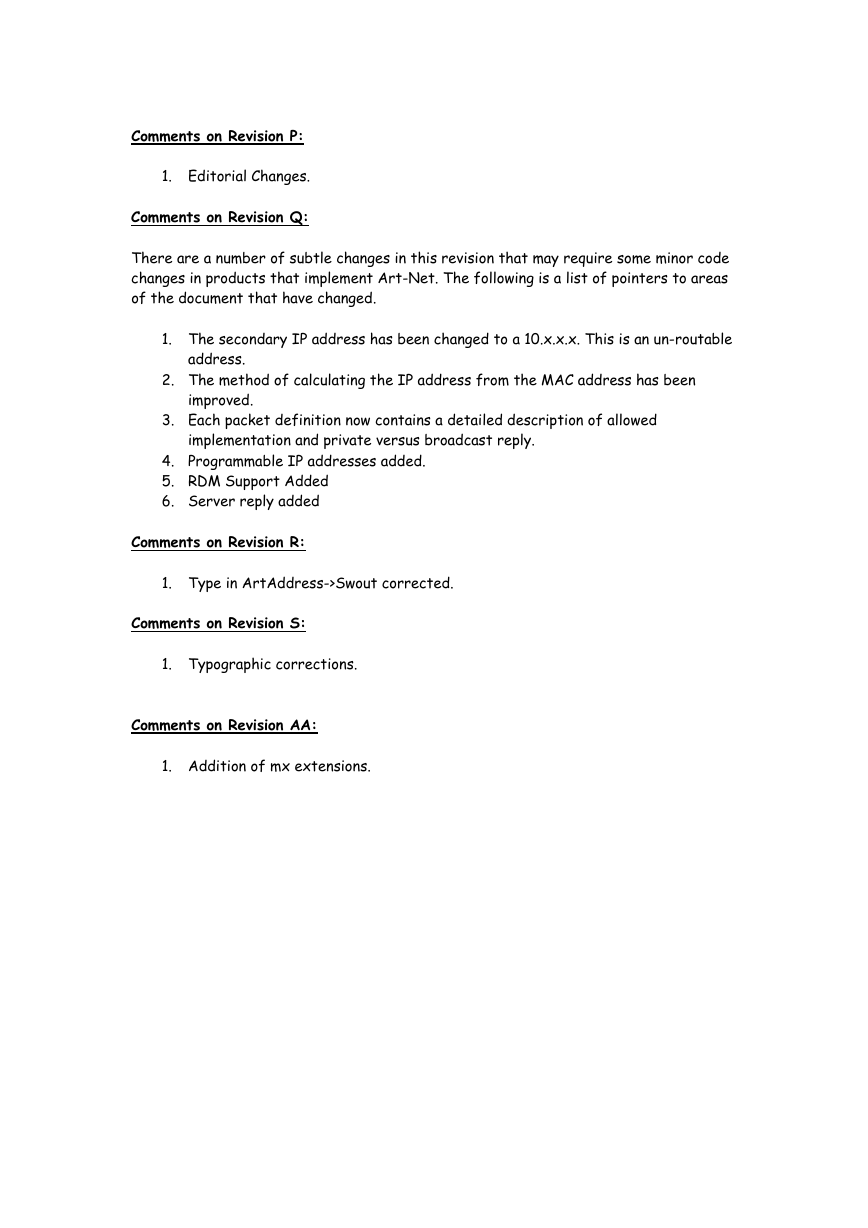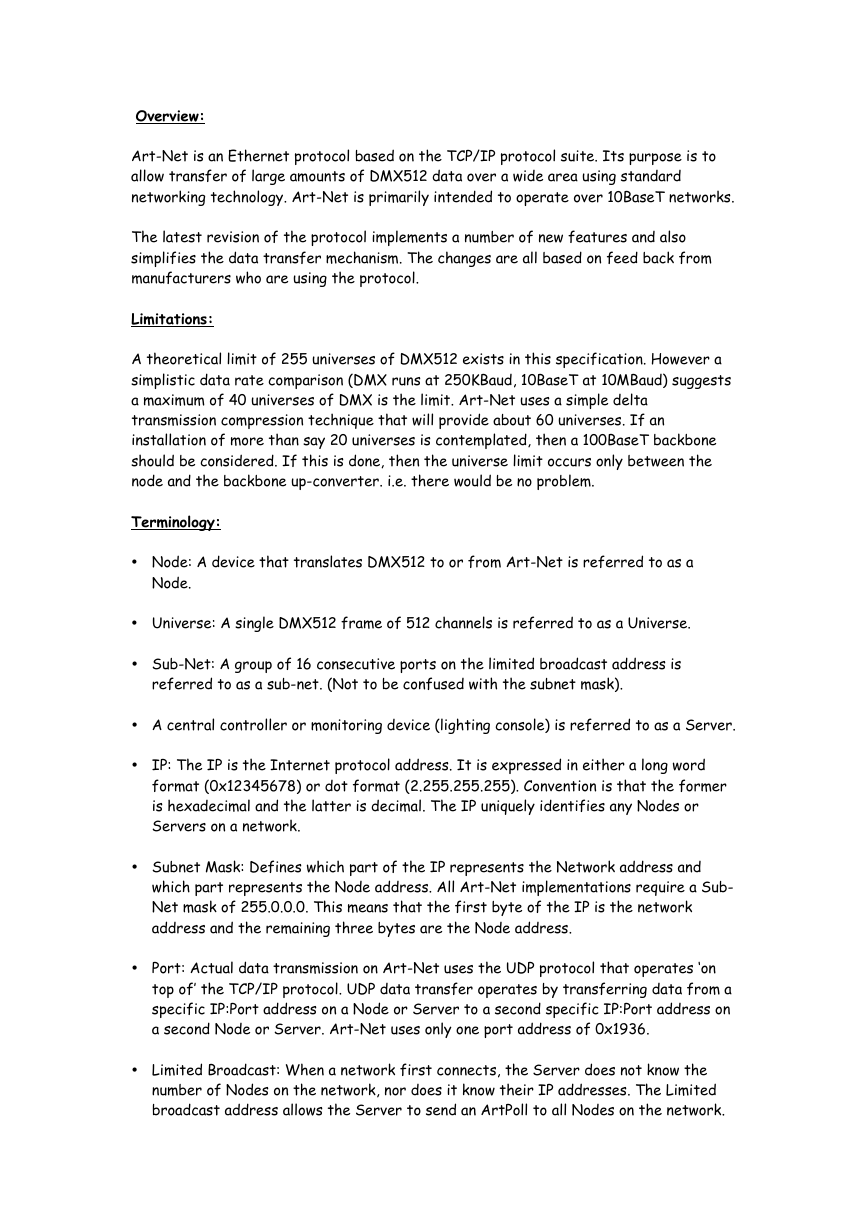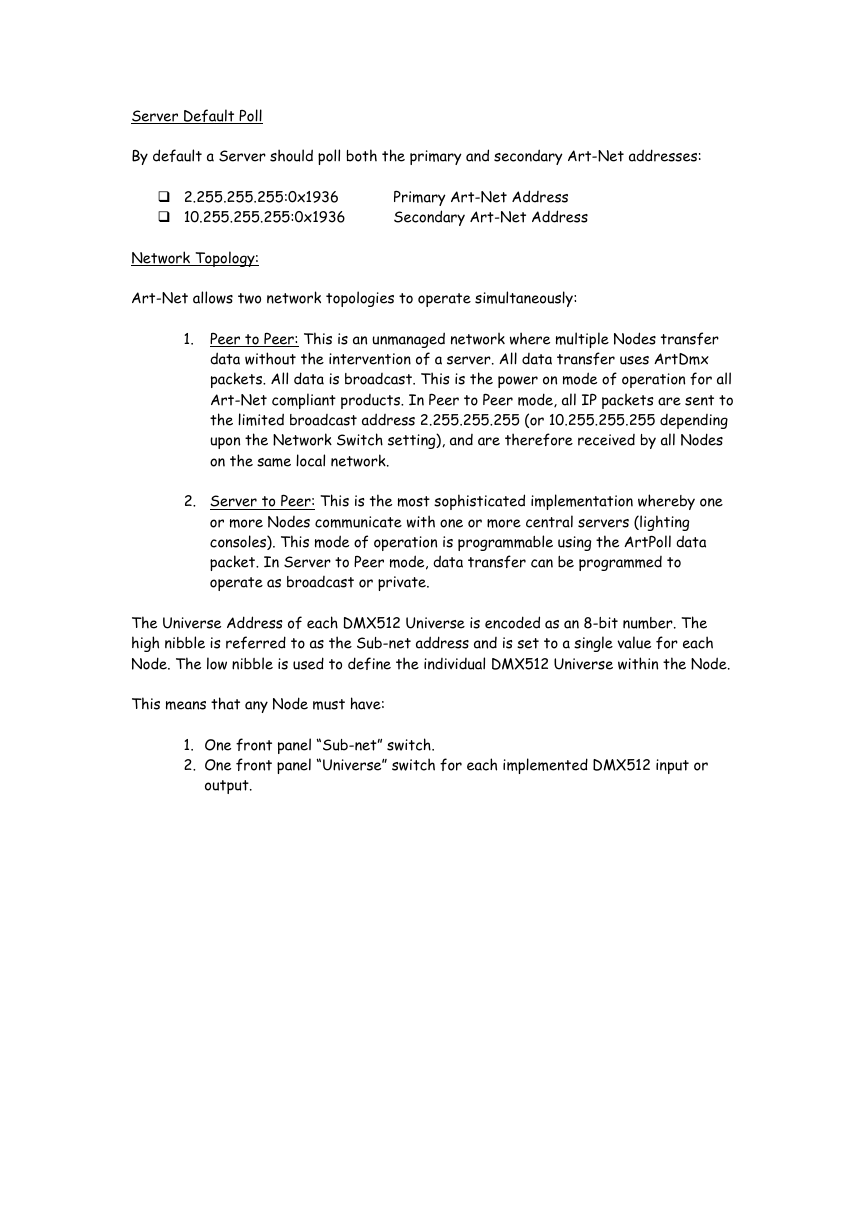Artistic Licence
Art-Net mx
Specification for the
Art-Net mx Ethernet Communication Standard
Release V1.4
Document Revision AA 1/4/04
© Copyright Artistic Licence (UK) Ltd 2002-2004 This document is released into the
public domain without warranty of any kind including but not limited to the implied
warranties of fitness for a particular purpose.
Any third parties are welcome to use this communication protocol without royalty.
Artistic Licence politely request that any manufacturer who implements this protocol
sends details to Support@ArtisticLicence.com so that a user database may be
Artistic Licence can only offer Email support for technical enquiries regarding this
maintained on our web site.
document.
�
�
Comments on Revision P:
1. Editorial Changes.
Comments on Revision Q:
There are a number of subtle changes in this revision that may require some minor code
changes in products that implement Art-Net. The following is a list of pointers to areas
of the document that have changed.
1. The secondary IP address has been changed to a 10.x.x.x. This is an un-routable
address.
improved.
2. The method of calculating the IP address from the MAC address has been
3. Each packet definition now contains a detailed description of allowed
implementation and private versus broadcast reply.
4. Programmable IP addresses added.
5. RDM Support Added
6. Server reply added
1. Type in ArtAddress->Swout corrected.
Comments on Revision R:
Comments on Revision S:
1. Typographic corrections.
Comments on Revision AA:
1. Addition of mx extensions.
�
�
Overview:
Art-Net is an Ethernet protocol based on the TCP/IP protocol suite. Its purpose is to
allow transfer of large amounts of DMX512 data over a wide area using standard
networking technology. Art-Net is primarily intended to operate over 10BaseT networks.
The latest revision of the protocol implements a number of new features and also
simplifies the data transfer mechanism. The changes are all based on feed back from
manufacturers who are using the protocol.
Limitations:
A theoretical limit of 255 universes of DMX512 exists in this specification. However a
simplistic data rate comparison (DMX runs at 250KBaud, 10BaseT at 10MBaud) suggests
a maximum of 40 universes of DMX is the limit. Art-Net uses a simple delta
transmission compression technique that will provide about 60 universes. If an
installation of more than say 20 universes is contemplated, then a 100BaseT backbone
should be considered. If this is done, then the universe limit occurs only between the
node and the backbone up-converter. i.e. there would be no problem.
Terminology:
• Node: A device that translates DMX512 to or from Art-Net is referred to as a
Node.
• Universe: A single DMX512 frame of 512 channels is referred to as a Universe.
• Sub-Net: A group of 16 consecutive ports on the limited broadcast address is
referred to as a sub-net. (Not to be confused with the subnet mask).
• A central controller or monitoring device (lighting console) is referred to as a Server.
• IP: The IP is the Internet protocol address. It is expressed in either a long word
format (0x12345678) or dot format (2.255.255.255). Convention is that the former
is hexadecimal and the latter is decimal. The IP uniquely identifies any Nodes or
Servers on a network.
• Subnet Mask: Defines which part of the IP represents the Network address and
which part represents the Node address. All Art-Net implementations require a Sub-
Net mask of 255.0.0.0. This means that the first byte of the IP is the network
address and the remaining three bytes are the Node address.
• Port: Actual data transmission on Art-Net uses the UDP protocol that operates ‘on
top of’ the TCP/IP protocol. UDP data transfer operates by transferring data from a
specific IP:Port address on a Node or Server to a second specific IP:Port address on
a second Node or Server. Art-Net uses only one port address of 0x1936.
• Limited Broadcast: When a network first connects, the Server does not know the
number of Nodes on the network, nor does it know their IP addresses. The Limited
broadcast address allows the Server to send an ArtPoll to all Nodes on the network.
�
• Server: A generic term describing an Art-Net device with the primary task of
generating control data. For example, a lighting console.
• Node: A generic term describing an Art-Net device with the primary task of
receiving control data. For example, a dimmer or an Ethernet to DMX gateway.
• Media Server: A generic term describing an Art-Net device capable of generating
control data based on the ‘mx’ Media Extensions to Art-Net.
Ethernet Implementation:
General Notes:
• All communication is UDP. Each packet format defined in this document form the
Data field of an enclosing UDP packet.
• Packet formats are specified in a manner similar to C-language structures, in which all
data items are considered to be unsigned integers of type INT8, INT16 or INT32
according to the number of bits. There are no hidden padding bytes, except at the
very end of a packet, which may be rounded up to a multiple of 2 or 4 bytes. Extra
bytes at the end of a valid received packet are ignored.
• The protocols are generalised for handling future versions with increased numbers of
ports.
• Many bit data fields contain unused positions. These may be used in future versions
of the protocol. They should be transmitted as zero and not tested by receivers.
• All packet definitions are designed such that their length can be increased in future
revisions, whilst retaining compatibility. For this reason, only minimum packet length
is checked in this protocol.
Protocol Operation:
A Node operates in one mode, each Node having a unique IP address derived from its
Ethernet MAC address. The UDP port used as sources and destinations is 0x1936.
IP address configuration
The Art-Net protocol, by default, uses a Class A IP address scheme. This allows Art-
Net products to communicate directly and without the need for a DHCP server to be
connected to the network. The use of Class A addressing is allowed within a closed
network. It is important to ensure that Art-Net data is not routed onto the Internet.
Products implementing Art-Net should default to the Primary IP address of 2.?.?.?.
�
The IP address consists of a 32 bit number designated as A.B.C.D. The lower the bytes
B.C.D is calculated from the MAC address. The high byte ‘A’ is set to one of two values
as shown in the following table.
The MAC address is a 48 bit number designated u:v:w:x:y:z. This is a globally unique
number. The upper three bytes ‘u.v.w’ are registered to a specific organisation. The
lower three bytes ‘x.y.z’ are assigned by that organisation. In order to ensure that there
is minimal possibility of IP address conflicts between different manufacturers
supporting Art-Net, the product OEM code is added to the MAC address.
The ‘B’ field of the IP address is calculated by adding the high byte of the OEM code
with the low byte of the OEM code and the ‘x’ field of the MAC address.
On power up, the Node checks its configuration for IP addressing mode. If it has been
programmed to use a custom IP address, the following procedure is not used.
Product Switch Settings
Custom IP Programmed
Network Switch Off
Network Switch On
A
2
10
IP Address A.B.C.D
D
C
B
As Programmed
x+OEM y
x+OEM y
z
z
Subnet Mask
As Programmed
255.0.0.0
255.0.0.0
The sub-net mask is always initialised to 255.0.0.0, unless a custom IP address is in use.
This means that the network address is the most significant 8 bits and the Node
address is the least significant 24 bits of the IP address. This is a Class A network
address and for this reason care must be exercised when connecting to other networks.
If an installation requires connection of an Art-Net network to another network that
has Internet access, then the connection must be implemented via a router that filters
out the Class A addresses.
IP address Example
Given the following settings, the IP address calculation will be as follows:
Network Switch = Off
MAC address = 12.45.78.98.34.76
OEM code = 0x0010
Calculation:
IP Address A = 2 (Because Network switch is off).
IP Address B = 114 (98 + 0 + 16).
IP Address C = 34 (from MAC address).
IP Address D = 76 (from MAC address).
IP Address = 2.114.34.76.
�
Server Default Poll
By default a Server should poll both the primary and secondary Art-Net addresses:
2.255.255.255:0x1936
10.255.255.255:0x1936
Primary Art-Net Address
Secondary Art-Net Address
Network Topology:
Art-Net allows two network topologies to operate simultaneously:
1. Peer to Peer: This is an unmanaged network where multiple Nodes transfer
data without the intervention of a server. All data transfer uses ArtDmx
packets. All data is broadcast. This is the power on mode of operation for all
Art-Net compliant products. In Peer to Peer mode, all IP packets are sent to
the limited broadcast address 2.255.255.255 (or 10.255.255.255 depending
upon the Network Switch setting), and are therefore received by all Nodes
on the same local network.
2. Server to Peer: This is the most sophisticated implementation whereby one
or more Nodes communicate with one or more central servers (lighting
consoles). This mode of operation is programmable using the ArtPoll data
packet. In Server to Peer mode, data transfer can be programmed to
operate as broadcast or private.
The Universe Address of each DMX512 Universe is encoded as an 8-bit number. The
high nibble is referred to as the Sub-net address and is set to a single value for each
Node. The low nibble is used to define the individual DMX512 Universe within the Node.
This means that any Node must have:
1. One front panel “Sub-net” switch.
2. One front panel “Universe” switch for each implemented DMX512 input or
output.
�
















 2023年江西萍乡中考道德与法治真题及答案.doc
2023年江西萍乡中考道德与法治真题及答案.doc 2012年重庆南川中考生物真题及答案.doc
2012年重庆南川中考生物真题及答案.doc 2013年江西师范大学地理学综合及文艺理论基础考研真题.doc
2013年江西师范大学地理学综合及文艺理论基础考研真题.doc 2020年四川甘孜小升初语文真题及答案I卷.doc
2020年四川甘孜小升初语文真题及答案I卷.doc 2020年注册岩土工程师专业基础考试真题及答案.doc
2020年注册岩土工程师专业基础考试真题及答案.doc 2023-2024学年福建省厦门市九年级上学期数学月考试题及答案.doc
2023-2024学年福建省厦门市九年级上学期数学月考试题及答案.doc 2021-2022学年辽宁省沈阳市大东区九年级上学期语文期末试题及答案.doc
2021-2022学年辽宁省沈阳市大东区九年级上学期语文期末试题及答案.doc 2022-2023学年北京东城区初三第一学期物理期末试卷及答案.doc
2022-2023学年北京东城区初三第一学期物理期末试卷及答案.doc 2018上半年江西教师资格初中地理学科知识与教学能力真题及答案.doc
2018上半年江西教师资格初中地理学科知识与教学能力真题及答案.doc 2012年河北国家公务员申论考试真题及答案-省级.doc
2012年河北国家公务员申论考试真题及答案-省级.doc 2020-2021学年江苏省扬州市江都区邵樊片九年级上学期数学第一次质量检测试题及答案.doc
2020-2021学年江苏省扬州市江都区邵樊片九年级上学期数学第一次质量检测试题及答案.doc 2022下半年黑龙江教师资格证中学综合素质真题及答案.doc
2022下半年黑龙江教师资格证中学综合素质真题及答案.doc